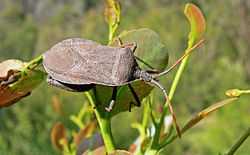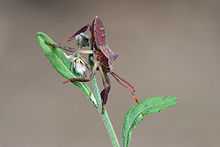Coreidae
| Coreidae | |
|---|---|
 | |
| Male Amorbus rubiginosus | |
 | |
| Coreid nymph | |
| Scientific classification | |
| Kingdom: | Animalia |
| Phylum: | Arthropoda |
| Class: | Insecta |
| Order: | Hemiptera |
| Suborder: | Heteroptera |
| Infraorder: | Pentatomomorpha |
| Superfamily: | Coreoidea |
| Family: | Coreidae Leach, 1815 |
| Subfamilies | |
|
Agriopocorinae (disputed) | |
The Coreidae are a large family of predominantly herbivorous insects (leaf-footed bugs) that belong in the hemipteran suborder Heteroptera.[1] More than 1,900 species are placed in over 270 genera.[2] They vary in size from 7 to 45 mm long, making the larger species some of the biggest heteropterans. The body shape of coreids is quite variable, with some species broadly oval while others are slender. Coreids are found throughout the world, but most species are found in the tropics and subtropics.
In North America, they are colloquially called "squash bugs", because some species, such as Anasa tristis, are pests of squash plants and other cucurbits.[3][4] They are also called “leaf-footed bugs” due to the leaf-like expansions some species have on their hind legs.
Some coreids, such as Phyllomorpha laciniata, exhibit parental care by carrying their eggs. This behaviour can protect the eggs from parisitism.[5]
Etymology
The name comes from the Ancient Greek κόρις meaning bedbug.[6]
Taxonomy
The family Coreidae belongs to the order Hemiptera and is closely related to the families Alydidae, Hyocephalidae, Rhopalidae, and Stenocephalidae. Together, these five families form the superfamily Coreoidea.
Morphology
The general morphological features of the Coreidae are an oval-shaped body, antennae composed of four segments, a numerously veined fore wing membrane, a metathoracic stink gland, and enlarged hind tibiae.[1][3] Many species are covered with spines and tubercles.[2]
Systematics
This group is most often divided into three or four subfamilies; some selected genera are:
Agriopocorinae Miller, 1953 (often included in Coreinae)
- Agriopocoris Miller, 1953
Coreinae Leach, 1815
|
|
Meropachydinae Stål, 1867
- Merocoris Perty, 1833
Pseudophloeinae Stål, 1867
- Bothrostethus Fieber 1860
- Ceraleptus Costa, 1847
- Coriomeris Westwood, 1842
Numerous tribes of the Coreinae have previously been proposed for elevation to subfamily rank, for example, the Agriopocorini, Colpurini, Hydarini, Phyllomorphini, and Procamptini, but the only one of these changes accepted at least by a significant minority of researchers today is the first, and even recent reviews generally tend to treat the proposed Agriopocorinae as a tribe again, recognizing only the three subfamilies known by 1867. In addition, at least the genus Eubule is of decidedly indeterminate placement.
| Wikimedia Commons has media related to Coreidae. |
| Wikispecies has information related to: Coreidae |
References
- ↑ 1.0 1.1 Gordh G, Headrick, D H (2000). A Dictionary of Entomology. CABI Publishing.
- ↑ 2.0 2.1 Schuh R T, Slater, J A (1995). True Bugs of the World (Hemiptera: Heteroptera). Classification and Natural History. Cornell University Press.
- ↑ 3.0 3.1 Baranowski, R M (1986). Coreidae of Florida (Hemiptera: Heteroptera). Florida Department of Agriculture and Consumer Services.
- ↑ Hawkins, R D (2003). Shieldbugs of Surrey. Surrey Wildlife Trust.
- ↑ Gomendio, M; García González, F; Reguera, P; Rivero, A (2008). "Male egg carrying in Phyllomorpha laciniata is favoured by natural not sexual selection". Animal Behaviour 75 (3): 763–770. doi:10.1016/j.anbehav.2006.12.029.
- ↑ http://www.treccani.it/vocabolario/coreidi/
External links
- Coreidae of Britain
- Coreidae of Florida
- Comparative description of the immature stages of two very similar leaf footed bugs, Holymenia clavigera (Herbst) and Anisoscelis foliacea marginella (Dallas) (Hemiptera, Coreidae, Anisoscelini)
- Coreidae (Heteroptera: Pentatomomorpha)
- Chelinidea vittiger aequoris, a cactus bug,
- Euthochtha galeator
- Leptoscelis tricolor, heliconia bug
- Leptoglossus phyllopus
- Spartocera batatas, giant sweetpotato bug